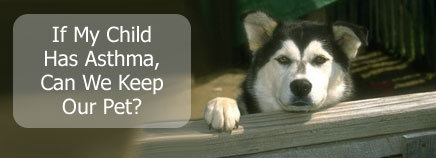
Only about 10% of people have pet allergies, but at least 30% of people with asthma are allergic to animals. So if your child has asthma, consider whether your pet could be producing allergens that are triggering asthma symptoms.
Despite what you might have heard, your pet’s fur probably isn’t to blame. Allergies are caused by the body’s reaction to a protein found in the animal’s dander (dead skin flakes), saliva, urine (pee), and feathers. Though pet hair itself isn’t the problem, this protein can cling to the fur when an animal licks itself.
Also, an animal’s fur can collect dust mites, pollen, mold, and other allergens. And any animal that lives in a cage (from birds to gerbils) will produce droppings that can attract mold and dust mites.
You may hear people say that certain breeds of dogs or cats, particularly those that don’t shed, won’t trigger asthma. But all warm-blooded animals shed allergy-causing proteins and are capable of causing an allergic reaction.
If you’re wondering whether your child is allergic to a pet, consider having him or her tested for allergies. If your child turns out to be allergic to your pet, you’ll have to decide whether to keep it or find it a new home. The best course is to remove the pet from your home, though this isn’t usually the easiest or happiest solution. Your child, other kids in the family, and even adults in the family may have a tough time with this decision.
In some cases, your doctor may say that it’s OK to keep a pet if your child receives medicine or allergy shots. If you go this route, you’ll still want to limit your child’s exposure to the animal, such as by keeping the pet out of your child’s bedroom and play areas. Hard as this is to enforce, try to teach your child not to hug or kiss the animal. Vacuum and dust regularly and avoid rugs and wall-to-wall carpeting, especially in your child’s room.
Unfortunately, such measures may not be enough. Because animal allergens are airborne, heating and ventilation systems will spread allergens throughout the house, even if the pet is kept out of bedrooms. Keeping the pet in the yard isn’t an ideal solution either because some allergens will eventually be carried in on clothing, and it’s not always safe for or fair to the pet.
If you decide to keep your pet, you might want to:
- Buy an air cleaner. HEPA air cleaners can really help, especially for cat allergies. Vacuums are available with HEPA filters as well.
- Keep your child away from the cat’s litter box, and place the box away from air vents.
- Have someone other than your child wash and brush your pet every week (this is advisable for cats as well as dogs).
- Encourage everyone in the family to wash their hands after playing with your pet.
- Keep your pet out of the child’s bedroom and away from rugs and upholstered furniture. You may need to shut the doors to certain rooms or use baby safety gates to keep cats and dogs out.
If you have a bird, gerbil, or other small caged animal, keep the cage in a room other than your child’s bedroom. Make sure the pet stays in its cage and clean it daily — without your child’s help. You’ll also want to let teachers know about your child’s allergies if there’s a caged pet in the classroom.
If you do decide to find another home for your pet, be sure to discuss this with your child. Assure your child it’s not his or her “fault” — and make sure siblings don’t blame the child. Losing a pet, even to a friend’s home, can be hard for everyone in the family.
Remember, too, that even if you remove the pet from your home, you may not see improvements in asthma symptoms for a while. It can take up to 6 months to reduce the allergen levels to those of a home without pets. Even if the pet is removed, your child might still need the asthma or allergy medications used previously.
When going to a house with a pet, your child should first take any prescribed allergy medicine and (as always) bring along his or her quick-relief medicine (also called rescue or fast-acting medicine).

